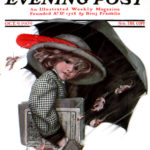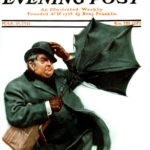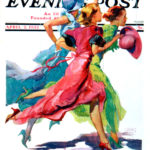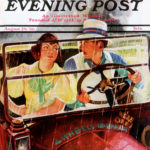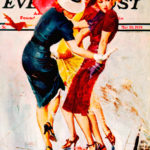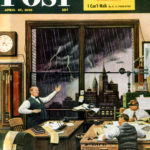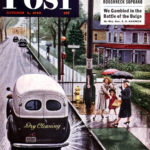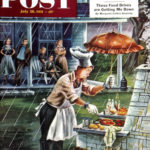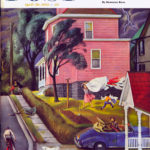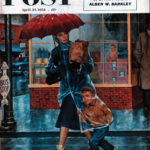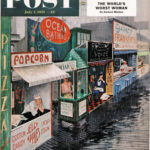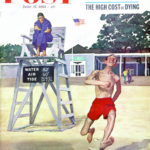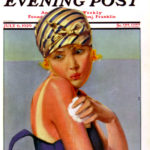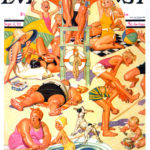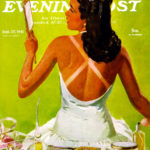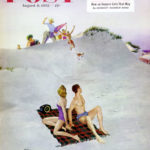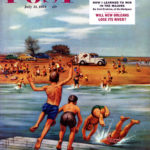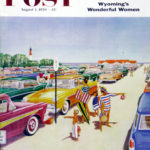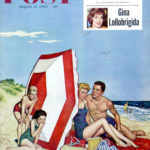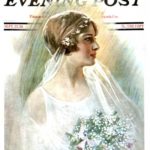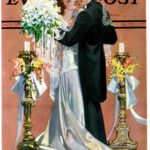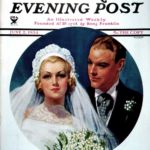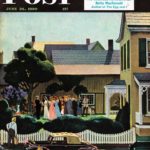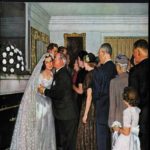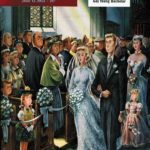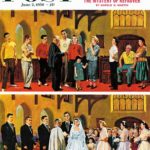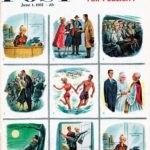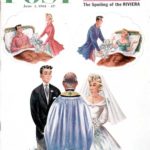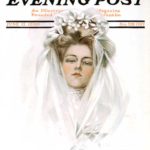January/February 2018 Limerick Laughs Winner and Runners-Up
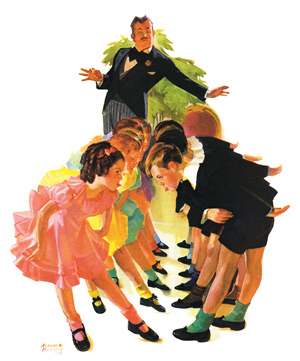
The students were taught by a master
But the dance class became a disaster
Cried one little mister,
“I’m paired with my sister!”
“So can’t we please dance any faster?”
Congratulations to Linda Neukrug of Walnut Creek, California! For her limerick describing Albert W. Hampson’s illustration Cotillion, which appeared as a Post cover on May 23, 1936, Linda wins $25 and our gratitude for a job well done.
If you’d like to enter the Limerick Laughs Contest for our upcoming issue, submit your limerick via our online entry form.
Linda’s was only one of a bunch of great limericks! Here are some of our favorites from our runners-up, in no particular order:
We’re lined up, all in our places
To practice polite social graces.
Some day this dance
May lead to romance,
But today we’d rather make faces.—Christine Coates, New Berlin, New York
They went to the junior cotillion,
Where she wore a dress of vermillion.
But what are the chances
These kids have more dances?
I’d say about one in a million.—Pat Cunningham, Cheektowaga, New York
They’ve probably practiced all day
To perform in this delicate way,
But the two kids in front
Add their own little stunt
To an otherwise perfect display.—Chet Cutshall, Willowick, Ohio
Dad said, “Just so that we are clear,
You will dance with your sister this year,
Or lose, if you like,
The use of your bike,”
Which explains the real reason I’m here.—Paul Desjardins, West Kelowna, British Columbia
The children’s performance was fine,
Their costumes and dancing divine.
One had to award ’em
High marks for decorum
… Except at the front of the line.—Michelle Gordon, Airway Heights, Washington
The French master’s class in the dance
Quite often would spark a romance.
But Sally and Sonny
Are nobody’s honey!
Which shows in their combative stance.—Lynn Johnson, Green Valley, Arizona
This girl who is dressed up in pink
Doesn’t know quite what to think:
Does this boy really hate her
Or wish he could date her?
She’ll obsess about this with her shrink.—Neal Levin, Bloomfield Hills, Michigan
“Excuse me, there’s no time to laugh.
Bow and curtsy and straighten the calf.
This is a cotillion;
You will look like a million
Or my salary will likely be half.”—Dolores M. Sahelian, Mission Viejo, California
In the ballroom, the young are taught graces
And how to trade spats for embraces,
But whether waltz or quadrille,
There are boys and girls still
Who wish only to trade nasty faces.—Rebecca Shulman, New Hope, Pennsylvania
January/February 2018 Limerick Laughs Winner and Runners-Up

The students were taught by a master,
But the dance class became a disaster.
Cried one little mister,
“I’m paired with my sister!”
“So can’t we please dance any faster?”
Congratulations to Linda Neukrug of Walnut Creek, California! For her limerick describing Albert W. Hampson’s illustration Cotillion, which appeared as a Post cover on May 23, 1936, Linda wins $25 and our gratitude for a job well done.
If you’d like to enter the Limerick Laughs Contest for our upcoming issue, submit your limerick via our online entry form.
Linda’s was only one of a bunch of great limericks! Here are some of our favorites from our runners-up, in no particular order:
We’re lined up, all in our places
To practice polite social graces.
Some day this dance
May lead to romance,
But today we’d rather make faces.—Christine Coates, New Berlin, New York
They went to the junior cotillion,
Where she wore a dress of vermillion.
But what are the chances
These kids have more dances?
I’d say about one in a million.—Pat Cunningham, Cheektowaga, New York
They’ve probably practiced all day
To perform in this delicate way,
But the two kids in front
Add their own little stunt
To an otherwise perfect display.—Chet Cutshall, Willowick, Ohio
Dad said, “Just so that we are clear,
You will dance with your sister this year,
Or lose, if you like,
The use of your bike,”
Which explains the real reason I’m here.—Paul Desjardins, West Kelowna, British Columbia
The children’s performance was fine,
Their costumes and dancing divine.
One had to award ’em
High marks for decorum
… Except at the front of the line.—Michelle Gordon, Airway Heights, Washington
The French master’s class in the dance
Quite often would spark a romance.
But Sally and Sonny
Are nobody’s honey!
Which shows in their combative stance.—Lynn Johnson, Green Valley, Arizona
This girl who is dressed up in pink
Doesn’t know quite what to think:
Does this boy really hate her
Or wish he could date her?
She’ll obsess about this with her shrink.—Neal Levin, Bloomfield Hills, Michigan
“Excuse me, there’s no time for laugh.
Bow and curtsy and straighten the calf.
This is a cotillion;
You will look like a million
Or my salary will likely be half.”—Dolores M. Sahelian, Mission Viejo, California
In the ballroom, the young are taught graces
And how to trade spats for embraces,
But whether waltz or quadrille,
There are boys and girls still
Who wish only to trade nasty faces.—Rebecca Shulman, New Hope, Pennsylvania
Cover Gallery: Bridal Wave
June means the start of wedding season. These Post covers show beautiful brides of the twentieth century.
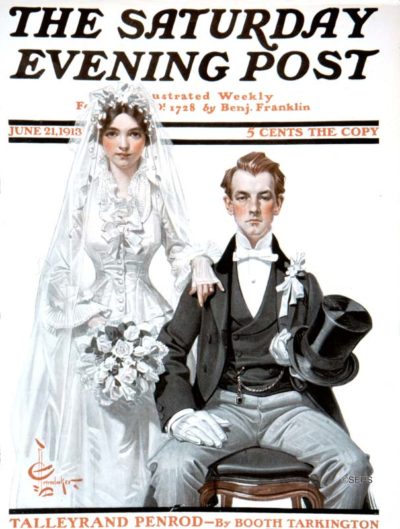
J. C. Leyendecker
June 21, 1913
In this painting by prolific artist J.C. Leyendecker, he shows a solemn couple having their photograph taken. Leyendecker illustrated the nuptial moments of other pairs, including Romeo and Juliet and Henry V and Catherine Valois. It appears this couple has got the “wedded” part down, if not the “bliss.”
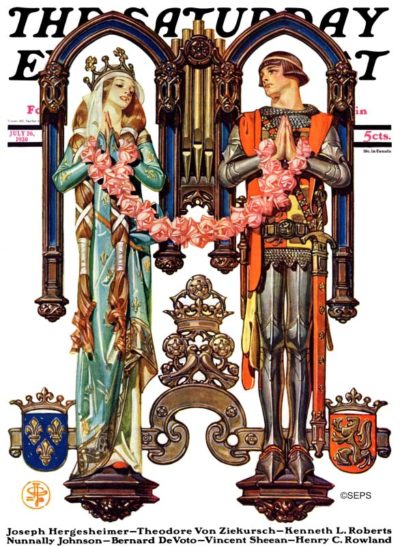
July 26, 1930
J.C. Leyendecker
Catherine of Valois married Henry V in June of 1420 and later gave birth to Henry VI. Henry V died shortly after his son’s birth, leaving the young Catherine a widow and her infant son the King of England.
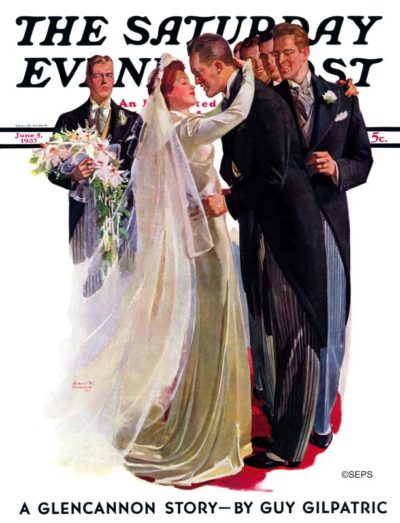
Albert W. Hampson
June 5, 1937
The groom doesn’t look too happy about this scenario. Given the line of enthusiastic groomsmen, the bride may not have enough energy for the honeymoon.
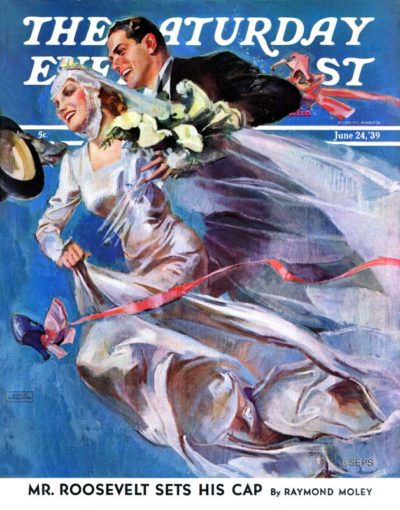
John LaGatta
June 24, 1939
LaGatta had an uncanny knack for translating from model to canvas an appreciation and sensual perspective of the female figure. LaGatta began his artistic process by sketching the models in charcoal and pastels and then would almost always refine his interpretation into an oil painting. His subjects were sophisticated, upper-class men and women with long graceful figures and with classic clothing designs. His images gave the impression that the models didn’t have a care in the world, as in this 1939 cover of a couple running off after their wedding ceremony.
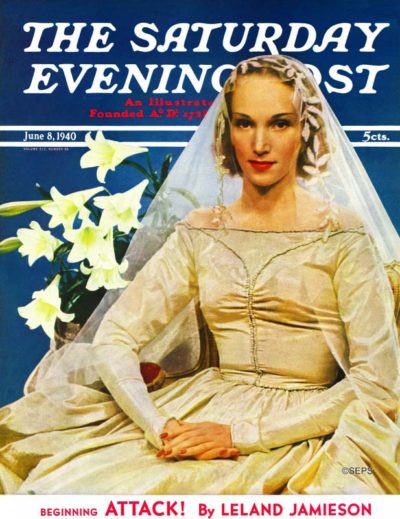
Wynn Richards
June 8, 1940
This 1940 bridal photograph was Wynn Richards’ one and only cover for the Saturday Evening Post. Richards was born “Martha Kinman Wynn” before marrying Dorsey Eugene Richards, according to her biography.. She opened her own photography studio in 1919, but left the business to a friend after a social scandal that involved her taking nude portraits of a local school teacher. Richards divorced her husband and left their son with his grandmother before opening a new portrait studio a few years later. Initially signing her work “Matsy Wynn Richards,” she learned that revealing her gender could hinder her career, and changed her signature to “Wynn Richards.” Richard’s work mostly appeared in Vogue, Harper’s Bazaar, and Mademoiselle magazine.
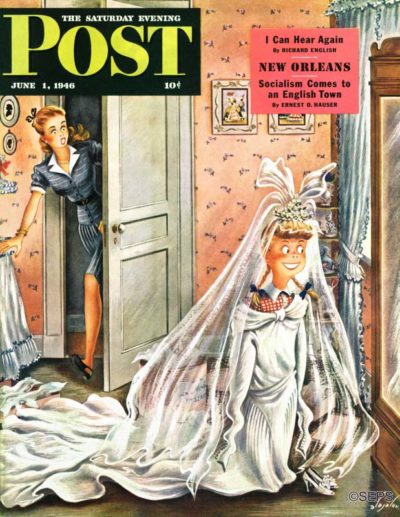
Constantin Alajalov
June 1, 1946
[From the editors of the June 1, 1946 issue of the Post] Just after Constantin Alajalov finished his kid-sister painting, he set out from New York for Florida, to work on other cover assignments. The artist went by automobile, and sent back a short report on his three-day journey. The highways are full of displaced persons at the moment, sorting themselves out after the great disruption of war, and we think Alajalov’s account is a thumbnail picture of America in Transition. “The first day,” he wrote, “I picked up a corporal just back from Tokyo, hitch-hiking to Alabama to marry a girl there. The second day I picked up a marine hitch-hiking to Jacksonville, Florida, to get his wife. The third day I picked up a sailor who was going to Miami for any girl he could get.”
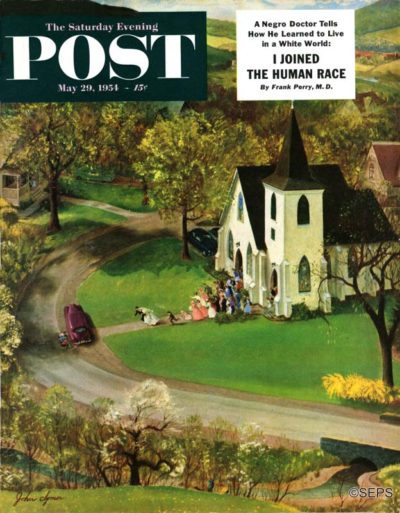
May 29, 1954
John Clymer
[From the editors of the May 29, 1954 Post] Away go the newly-marrieds into their brave new world and thank heaven it isn’t raining. John Clymer is nice about weather; on his covers it hardly ever rains. That church, says Clymer, is located in one state and the landscape in another state, and the honeymoon will take place in the state of bliss always visited on such trips.
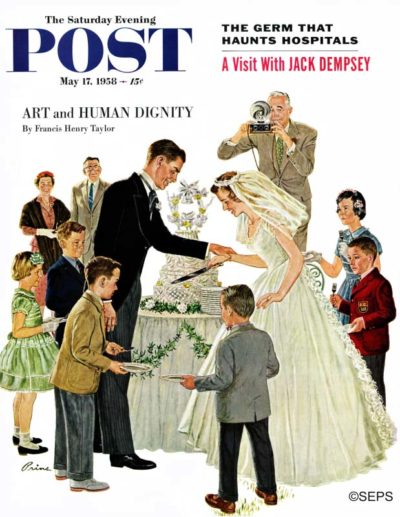
May 17, 1958
Ben Prins
[From the editors of the May 17, 1958 Post] Here come the bride and groom to carve the cake. Two-handed carving isn’t an efficient way to dismember food, but He and She have just become One and this is the tender symbol of their unity. They probably aren’t hungry; in a day or two food will become attractive, but right now they are not of this world, they are up in the clouds, in a state of bliss where folks subsist on love alone. Conversely, those youngsters have their feet on the ground and their eyes on the cake. Oh, the girls may save a few crumbs to put under their pillows to incite romantic dreaming, but the boys will put their cake where it belongs, and let’s hope they don’t consume enough to turn dreams into nightmares. Well, a toast to artist Ben Prins’ newlyweds: bon voyage, all the way through life!
Classic Covers: Rain, Rain, Go Away!
American poet and educator Henry Wadsworth Longfellow perhaps said it best: “Into each life some rain must fall, some days must be dark and dreary.” The rainy days on our Post covers show the dark and dreary, the frustrations along with the humor that accompanies a downpour. No fair weather friends, our cover artists!
Dating Rule No. 1: If trying to impress a girl with your fancy convertible, be sure a downpour isn’t in the works. In Albert W. Hampson’s 1936 cover, the young lady is clearly not impressed—whatever the make or model—when the rain comes. The expression on the young man’s face clearly says, “I have so blown it.” Well, at least she wasn’t wearing a lovely hat to ruin, such as the pretty lady in Douglass Crockwell’s April 8, 1939, cover. But she’s a clever lass—she’s pulling down the handy Post cover for protection!
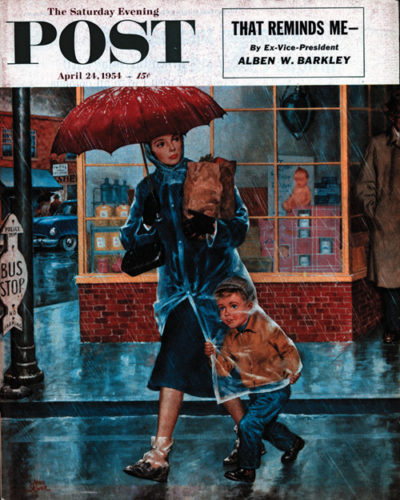
Boy Walking Under Mother's Raincoat
April 24, 1954
Also showing good ol’ American ingenuity is the young boy on Amos Sewell’s April 24, 1954, cover. Since mom’s raincoat is clear plastic, he figured out a way to walk in the rain, see where he’s going, and keep himself quite dry—well, at least the top half.
Downpours help us discover speed we didn’t know we had. In the 1950s, you not only worried about getting the top up on your convertible when a Midwest storm blew in, you had to scurry to get the laundry off the line. Artist John Falter remembered the “hair-curling lightning and thunder” in that part of the country from his boyhood, and his April 26, 1952, cover shows that Mother Nature clearly plans to take no prisoners. Also dodging raindrops are three charming ladies on John LaGatta’s colorful April 2, 1932, cover.
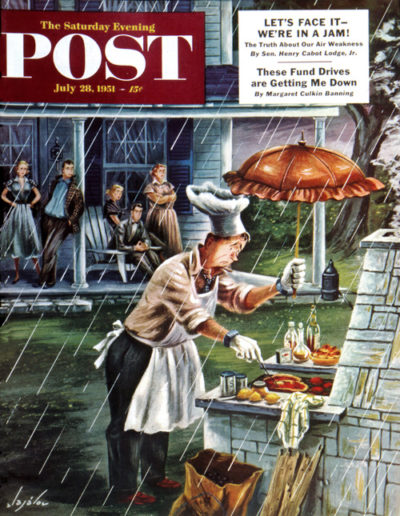
Constantin Alajalov
July 2, 1955
Let’s visit the local drive-in. Or is it the local float-in? On John Falter’s May 13, 1961, cover, our real-life hero protects burgers and shakes from the pouring rain as he scurries through the puddles to nourish his hungry troops. Rain or shine, the show must go on! Much more difficult than negotiating puddles to feed the family is cooking food in the rain, as seen in Constantin Alajalov’s July 1951 cover. You would think one of the slackers on the porch would at least hold the umbrella for the poor cook.
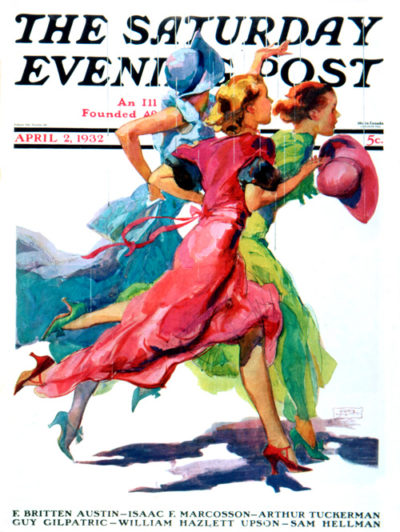
Ladies Running From Rain
April 2, 1932
Sarah Stilwell-Weber, who delighted Post readers in the early 1900s with her beautiful paintings of children, shows a girl walking in the rain, balancing schoolbooks and an umbrella on the October 9, 1909, cover. Having less luck with his umbrella is the gentleman in Robert Robinson’s March 18, 1911, cover. Holding on to your hat and an inside-out umbrella at the same time takes dexterity.
Another trio of beautifully dressed LaGatta ladies are getting splashed by a passing car in the May 20, 1939, cover. But leave it to a Post cover artist to find irony, as in one of our favorite rainy-day covers from October 2, 1948. Three pedestrians are being splashed by a passing truck. But not just any truck, dear friends, a delivery vehicle for the local dry cleaners.
On the bright side, our cover research found someone happy about the storms! Stevan Dohanos’ April 1946 cover shows gentlemen from the New York weather bureau delightedly noting the lightning storm outside. While there’s no fun getting wet, there’s a certain pleasure in getting it right!
Gallery
Girl with Schoolbooks in Rain
October 9, 1909
Man with Inside-out Umbrella
March 18, 1911
Ladies Running From Rain
April 2, 1932
Couple in Convertible
August 29, 1936
Lady in Hat in Rain
April 8, 1939
Ladies Getting Splashed
May 20, 1939
Weatherman Was Right
April 27, 1946
Splashed by Dry Cleaning Truck
October 2, 1948
Rainy Barbeque
July 2, 1955
Storm Coming
April 26, 1952
Boy Walking Under Mother’s Raincoat
April 24, 1954
Rain on the Boardwalk
July 2, 1955
Rainy Drive-In
May 31, 1961
Classic Covers: Life’s a Beach
Some people are in heaven at the beach. Take the pretty lady on the left in Kurt Ard’s August 1958 cover. To her husband, who must burn and peel easily, the beach seems more like that other place. But coated with a variety of potions and covered up to the chin, he is making the sacrifice for her. Perhaps she’ll return the favor tomorrow and settle for a shady spot.
What that man has discovered, the young lady in the July 6, 1929, cover is just finding out: Too much sun can be painful. Or, at least, inconvenient, as we see from the tan lines of the lady in Albert W. Hampson’s September 27, 1941, cover. The stripes of her bathing suit do not line up with the lovely backless dress she wants to wear. (Oops.)
The best way to enjoy the beach is to find a nice secluded spot away from the madding crowds. What usually happens, though, as in George Hughes’ August 8, 1953, cover, is that others soon find that perfect spot, after which, alas, is not so perfect.
We bet you thought crowded beaches were a modern-day phenomenon. J.C. Leyendecker’s September 3, 1932, cover shows a joyously crowded beach with all kinds of characters, topped off by a strapping lifeguard. Not so joyously crowded is the beach scene showing a confused family trying to find their car on the August 1, 1959, cover. Mom thinks it’s this way, but Dad and junior are inclined to think it’s that way. We hope they find it before everyone gets fried.
You have to love the die-hards. Take Smiley (we’re pretty sure that’s his name), on the June 17, 1961, cover. He’s gung-ho about plunging into the posted 52-degree water in spite of the covered-up lifeguard who clearly thinks he’s nuts. Life is short. You have to take advantage of beach days.
Cold Water Swimmer
June 17, 1961
Sunburn
July 6, 1929
King of the Beach
September 3, 1932
Tan Lines
September 27, 1941
No Chance to Be Alone
August 8, 1953
Storm at Beach
July 10, 1954
Ice Cream Truck at the Beach
July 31, 1954
Sunscreen
August 16, 1958
Beach Parking Lot
August 1, 1959
Eavesdropping on Love
August 13, 1960
Classic Covers: In Honor of June Brides
Oh my. There seems to be a conflicting view of married life already, and we’re only at the altar. In artist Constantin Alajalov’s June 1961 cover, the dreamy groom is visualizing a blissful married life, complete with breakfast in bed. Isn’t that the way marriage is? But it seems the lovely bride has visions of sugarplums served in bed as well, as no doubt he promised. We’re guessing reality is not far away for this charming couple.
In the montage Story of Love, also by Alajalov, there is the whole, well … story of love. We see “Miss Efficiency,” as the editors dubbed her, hard at work at her desk. Ah, but you never know what’s around the corner. In scene two, she is introduced to Mr. Right himself, then we see several dates and a wedding by scene six. Then a honeymoon, joyous bounce over the threshold, followed by Miss Efficiency, er, excuse us, Mrs. E., back at her desk again.
Philip Boileau, Post cover artist in the early 1900s, showed us a lovely (or a bit haughty) bride on the June 12, 1909, cover, and we’ve highlighted charming brides over the years, particularly striking examples being W. Haskell Coffin’s bride of September 25, 1926, and Ellen Pyle’s fetching bride with bouquet aloft on the October 13, 1928, cover. Do not fear that all was grace and charm in the early Post covers, dear reader. Artist Albert W. Hampson’s June 5, 1937, cover shows a bride kissing the best man … and a groom looking none too happy about it. We certainly hope there isn’t trouble in that paradise.
But we’re rather fond of the wedding realism of the 1950s. John Falter’s Backyard Wedding of June 24, 1950, is delightful, and Earl Mayan’s 1956 cover of “before and after” shows a wedding rehearsal in striking contrast to the actual event. In the top frame, well, we don’t want to say “what a bunch of slackers,” but we have a couple of yawns, a lady applying makeup, and a flower girl playing with a yo-yo (these days it would probably be a hand-held video game). But out of jeans, T-shirts, and without crossed arms and other expressions of “when is this going to be over?” the wedding party cleans up real good, as they say. We’re happy the wedding turns out beautifully—our hope for all June brides.
Stevan Dohanos
